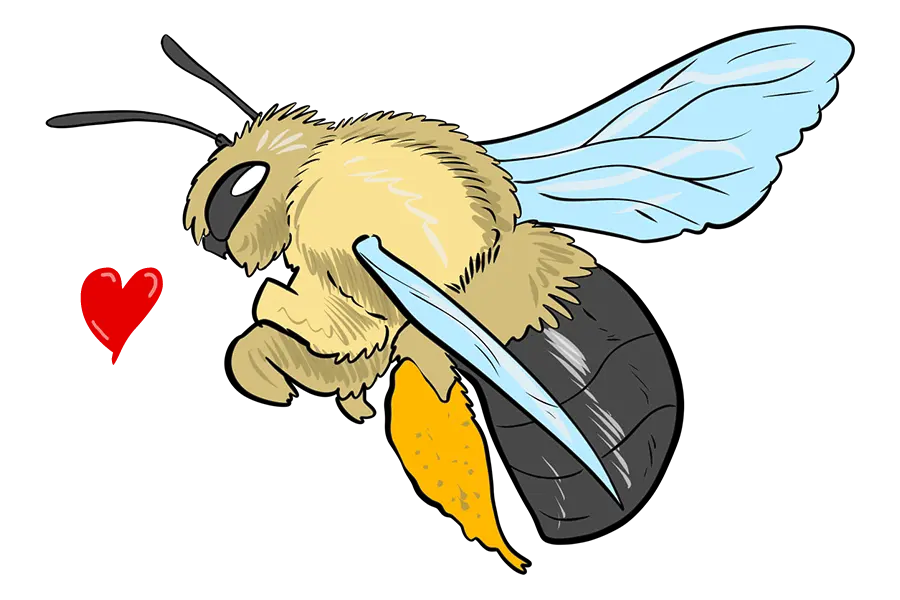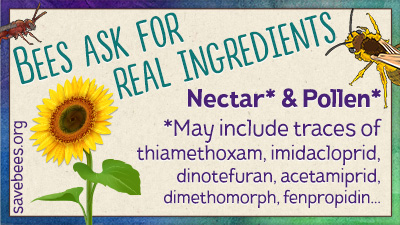
Unsurprisingly, bees would avoid these *extras* if they could!
As of 2020, around 7 billion pounds (3.5 million tons) of pesticides are applied annually worldwide. This figure is now likely closer to 8 billion pounds (4 million tons).
These figures are astoundingly high, considering that newer pesticides are often much more toxic by weight (e.g. neonicotinoids are 7000 times more toxic to bees than DDT)—and considering that these chemicals often accumulate in the environment, or break down into other toxic substances. These figures are increasing every year.
In the United States, the figure is now over 1 billion pounds (half a million tons) of pesticides annually. Astonishingly, close to half a million pounds of pesticides are even applied annually on U.S. national wildlife refuges.
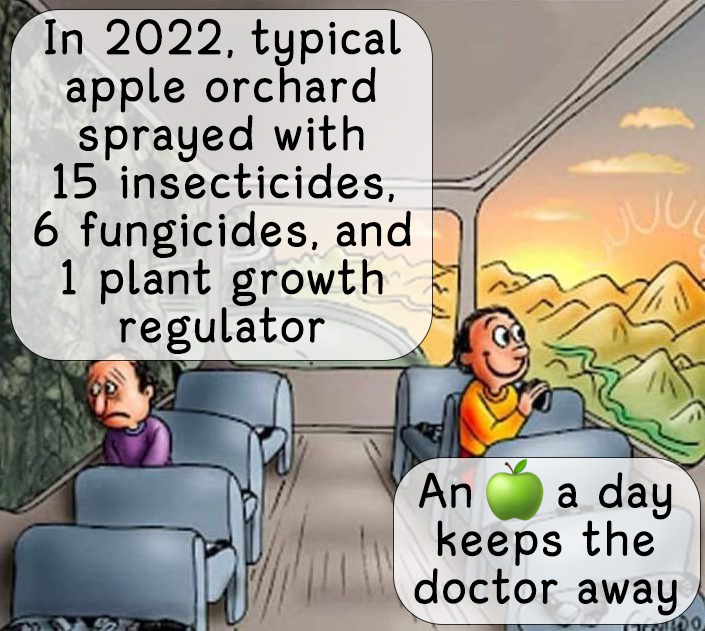
In 2016, Washington farmers used more than 200,000 pounds of chlorpyrifos on their [apple] orchards and vineyards. Chlorpyrifos is a neurotoxic pesticide that can cause lower IQs, higher levels of ADHD, and poor impulse control when children and developing fetuses are exposed.
Pesticide effects may be lethal and quick, or subtle and chronic (and all shades in between). The degree of harm depends on many factors, such as:
- Type of chemical & its amount
- Other chemicals present & their amounts
- Method of application
- Time of day & time of year
- Species present & their overall health
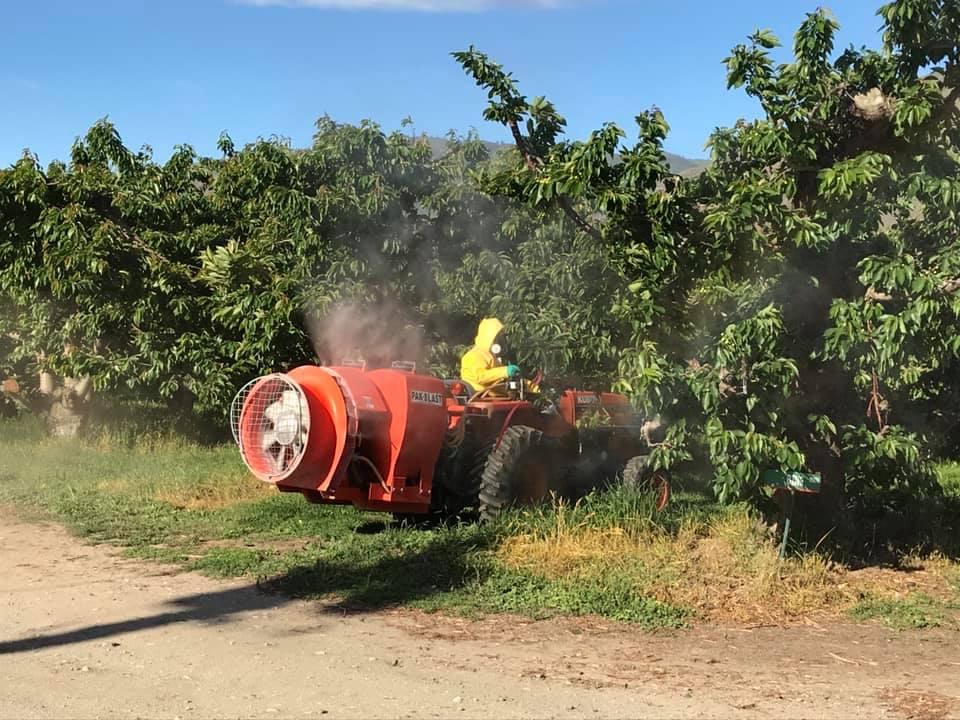
Is this how you imagined an apple orchard?
Tank mixes: toxic combinations
There are several concerning methods of application. One of these is the tank mix, wherein a number of pesticides are mixed together all at once, so that they may be sprayed in one pass by a crop sprayer. This is done because it is simpler and more cost-effective to spray in one pass. However, these chemicals are almost never tested together for safety, and some classes of chemicals (such as fungicides) are known to make other pesticides more potent and thus more toxic.
Systemic insecticides: the plant itself becomes the pesticide
One of the newer classes of pesticides are the systemic neonicotinoids (neonics for short). Although there are several methods of application, one of the most popular is to coat seeds in these pesticides, which are then expressed by every part of the plant—including its nectar and pollen—rendering the plant itself toxic.
Toxic pets: flea & tick treatments
These neurotoxic neonicotinoids are also the ones found in popular pet flea and tick treatments: in effect, rendering the whole cat or dog poisonous. One dog-dose suffices to kill 60 million bees.
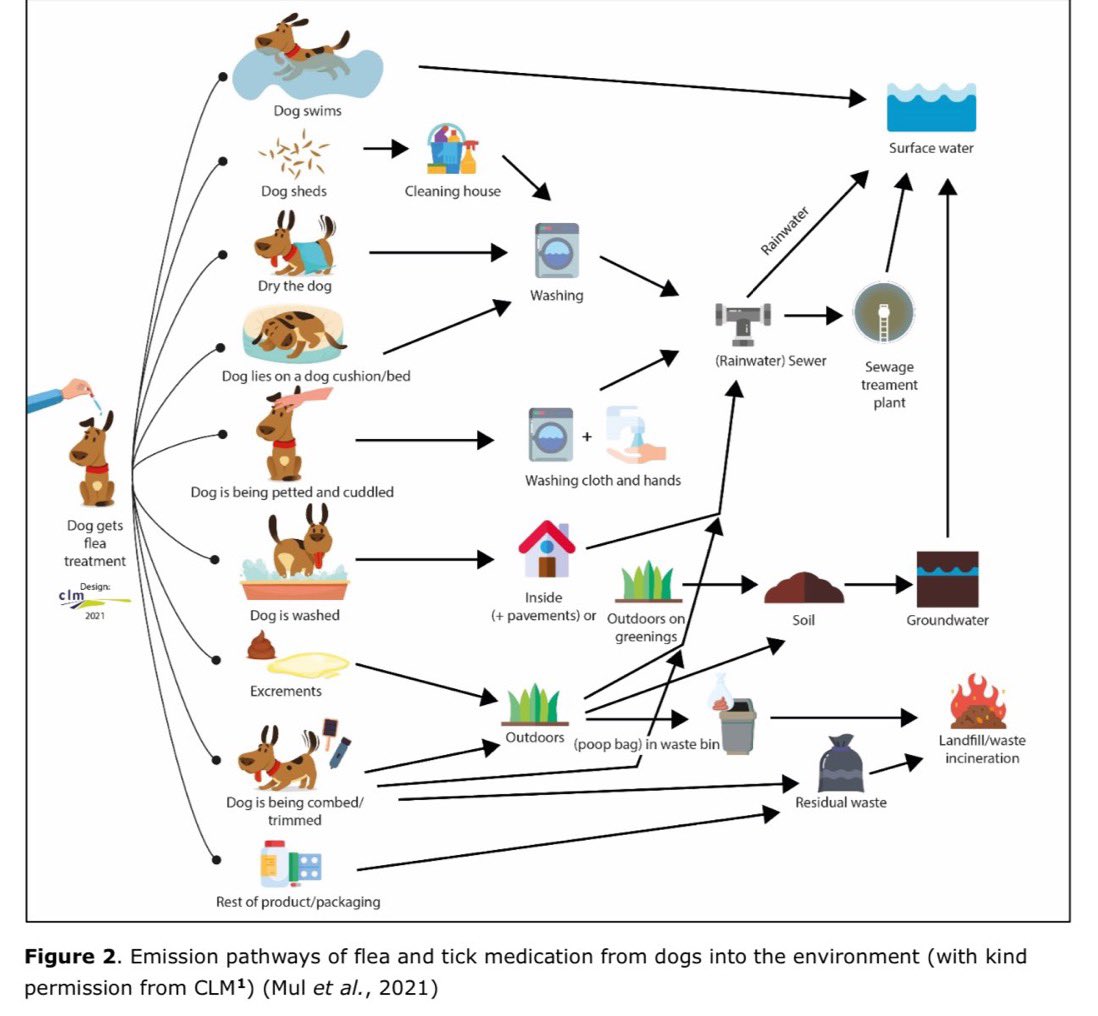
Pesticide production took off in the 50’s
Pesticides feel like relative newcomers on the scene of human history. It is true that in ancient times some attempts were made, but these were few and primitive compared to the dizzying array of introductions we've had since chemical companies began looking for ways to pivot from their original wartime products, to something they could sell in peacetime.
Two herbicides go into making Agent Orange: 2,4-D and 2,4,5-T. The first of these is still in use today: in fact, it is added to RoundUp to make a potent combination herbicide to deal with the RoundUp resistant weeds that emerging after the colossal overuse of RoundUp.
In recent decades (thanks to a great deal of research, development and marketing), pesticides have come to be considered an essential tool for food production... as well as bringing us pest-free homes and workplaces, even pest-free home gardens and pets).
It makes sense that some people genuinely believe we must rely on agrochemicals in order to feed an ever-growing global human population. After all, it's all been working out (for the most part) for a number of decades.
This approach typically goes hand-in-hand with farming operations dedicated to single crops at massive scales, relying on highly optimized balances of inputs (fertilizers, fungicides, insecticides, and herbicides). Globalization has played an essential role (to take just one example, California provides almost all the world's almonds).
By and large, this is how things are currently done, and there's no doubt that many humans have both benefited from and relied upon these systems throughout much of our lives (variations upon these food systems have likely played a part in your being here to read this). But the costs are mounting, as ever more toxins are pumped into the environment (as of 2022, 4 million tons of pesticides are now applied annually worldwide).
“The soil is tilled with nitrogen and phosphate fertilizers. The ground under the trees is soaked in herbicides to keep the area beneath the canopies clear. The trees are sprayed with fungicides to combat nasty diseases like jacket rot and ground rot, and with pesticides to combat worm infestations.”
—John Miller, fourth-generation commercial beekeeper, speaking of almond trees in The Beekeeper's Lament: How One Man and Half a Billion Honey Bees Help Feed America
Chemically-dependent farming is ill-fated
Some people feel strongly that these modern agricultural systems are, in effect, borrowing from our future to provide us with short-term gains. These folks point to diminishing biodiversity and bioabundance, along with ever-increasing degradation of topsoil, waterways, and the air.
Many crop yields will fall as pollination falls
The thinking is that if we substantially reduce pollination, along with stripping soil of its fertility and water of its purity over time, we will surely hasten a future in which our harvests will no longer feasibly feed the human population.
Rather than coating crops with pesticides that harm pollinators (often applied as a kind of insurance, regardless of any known pests), we could instead enlist natural predators such as wasps, ladybugs, lacewings and others.
Crop rotation and crop diversity also reduce the likelihood of plagues of pests that find our unending fields of their favorite plants so tastily attractive. Add native wildflower strips and wild bee nesting sites, and crop yields go up.
Crop nutrition is also falling significantly
Many of our most nutritious foods like fruits and veggies depend on pollination. But as a species, we're consciously reducing these crop yields. We ask bees to live in a world for which they never evolved: vast flowerless expanses, unseen poisons, habitat disturbance and climatic extremes.
Consider that the nutritional content of the foods we eat has also been dropping since the 1950’s. Not just small drops either: depending on where you look, it's 10% here, 15% there, and close to 40% in some (note that it's a complex story as to why, owing to farmers selecting for yields and cosmetic perfection, rising carbon dioxide levels, and agricultural methods that deplete critical soil microbes and mycorrhizae).
"Sadly each successive generation of fast-growing, pest-resistant carrot is truly less good for you than the one before… Yet another study concluded that one would have to eat eight oranges today to derive the same amount of Vitamin A as our grandparents would have gotten from one.”
—Dirt Poor: Have Fruits and Vegetables Become Less Nutritious? (Scientific American)
Just when we need to produce more food
These losses mean we either have to produce even more crops to make up for these nutritional deficiencies, or change the way we produce food to restore crops' nutritional profiles. Considering that many people are also encouraging each other to pursue plant-based diets, it seems we'll need ever-more space in which to grow enough food to feed the growing world population (now over 8 billion people).
It is worth noting that in early 2017, after reviewing all the available evidence, United Nations experts denounced the myth that pesticides are needed to feed the world.
The increasing popularity of organic agriculture, farmers' markets, and more localized food production suggest different styles of food production.It can be delightful to enjoy more local and seasonal produce (and healthier)! Seasonal foods add variety to dishes year-round (even the depths of winter has its own local flavors, and many seasonal foods may be frozen, preserved or dried).
Stories from inside the EPA
“Americans ought not to drop dead from breathing air or drinking water or eating food poisoned by chemicals. Rivers (like Cleveland's Cuyahoga) ought not to catch on fire.”
—E.G. Vallianatos, in his book Poison Spring, describing the consensus in 1970 that prompted founding the EPA
The EPA had its origin in the Nixon administration. Although Nixon was hardly an environmentalist, it was too hard to ignore the issues at the time:
“The great question of the seventies is, shall we surrender to our surroundings, or shall we make our peace with nature and begin to make reparations for the damage we have done to our air, to our land, and to our water? Clean air, clean water, open spaces-these should once again be the birthright of every American. I see an America in which we have made great strides in stopping the pollution of our air, cleaning up our water, opening up our parks, continuing to explore in space.”
—Nixon, in his 1970 State of the Union speech
As early as 1947, scientists noticed that bees behaved poorly after encountering pesticides. An Arizona Agricultural Experiment Station Bulletin from 1947 (credited to S. E. McGregor and C. T. Vorhies) notes that poisoned bees landed "on leaves, twigs, or lumps of soil, selecting warm spots, and generally sitting motionless unless disturbed. Sometimes they fell from these perches, then revived and departed slowly, as a cold bee does, or in erratic flight to alight again a few yards away. In crawling they were much slower than arsenic poisoned bees. After becoming unable to crawl they would be helpless, sometimes for hours if protected from direct sun. They often lay on their backs or sides making feeble movement with legs and antennae."
Contrast those observations with the marketing for DDT in a Time magazine ad in 1947:
“The great expectations held for DDT have been realized. Exhaustive scientific tests have shown that, when properly used, DDT kills a host of destructive pests, and is a benefactor of all humanity.”
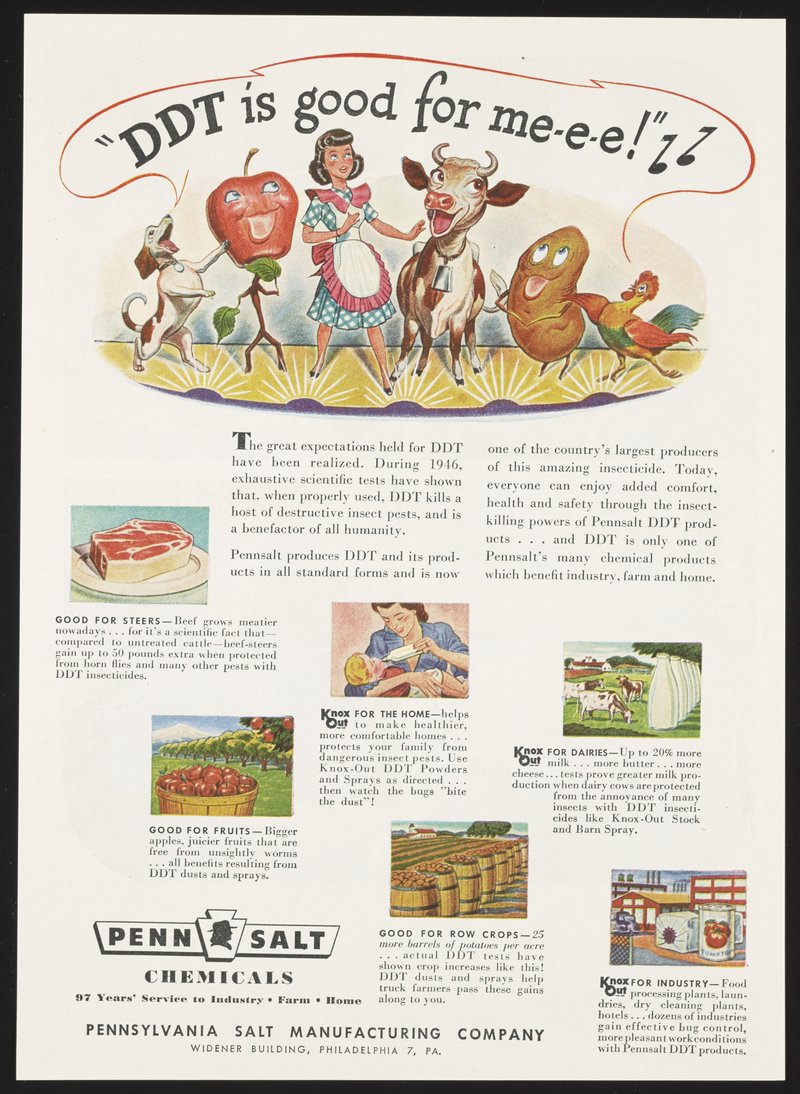
Incredibly, although it was banned in 1972, the EPA continued to register products contaminated with up to 20% DDT into the Reagan years.
EPA regulatory decisions, such as the banning of DDT, and then the banning of 2,4,5-T (Agent Orange's other half, along with the still legal 2,4-D) have prompted such a fierce backlash from industry, that those within the EPA have felt their organization hobbled as a result. In the Reagan years, EPA workers were even ordered to destroy years of data from studies by EPA scientists.
"First it was the eerie images of barrels leaking on the seafloor not far from Catalina Island. Then the shocking realization that the nation’s largest manufacturer of DDT had once used the ocean as a huge dumping ground — and that as many as half a million barrels of its acid waste had been poured straight into the water.
Now, scientists have discovered that much of the DDT — which had been dumped largely in the 1940s and ’50s — never broke down. The chemical remains in its most potent form in startlingly high concentrations, spread across a wide swath of seafloor larger than the city of San Francisco."
—Scientists uncover startling concentrations of pure DDT along seafloor off L.A. coast (LA Times)
Although the EPA once had its own research laboratories serving the Office of Pesticide Programs, these were reduced over the years: dropping from a dozen in 1971 to a half dozen in 1979, and by 2004 only two remained.
This means that the companies being regulated have become primarily responsible for submitting their own studies to the EPA.
To make matters worse, there appears to be a revolving door policy (with high-ranking officials coming from pesticide companies, and even returning to the EPA again later). There has been increasing pressure to politicize the EPA. And over the years, EPA scientists have been given reasons to fear (or incentives not to) challenge industry.
“And so it has gone with toxic chemicals over and over and across the decades: scientists collect data and issue warnings, and people in charge of making political decisions—many of them intimidated by (or beholden to) large corporations—ignore them.”
—E.G. Vallianatos, who spent 25 years as an analyst for the Environmental Protection Agency (EPA), in his book Poison Spring: The Secret History of Pollution and the EPA
Let me introduce Dave Goulson
If you don't already know of him!
Take a moment with me to spend some time considering Dave Goulson's thoughts, which are well worth considering, owing to his substantial scientific expertise, coupled with a healthy skepticism and willingness to go where the data goes.
His depth of knowledge comes from a lifetime dedicated to bees: in 2006 he founded the Bumblebee Conservation Trust, and throughout the course of his university career (as a professor at the University of Sussex specializing in bee ecology), he has authored over 300 scientific articles on the ecology and conservation of bumblebees and other insects.
I remember reading in one of his early books that he began his studies feeling skeptical that certain kinds of pesticides—known as neonicotinoids (neonics for short)—were as detrimental to bees as some were beginning to suspect at the time. According to him, the science bears out their singularly destructive nature.
When I heard him speak recently (in early 2022), he emphasized that neonics are 7000x more toxic to bees than DDT (just a teaspoon, he said, would wipe out 1.25 billion honey bees). And these substances contaminate the soil and water for years, as well as the plants themselves (when applied customarily as a seed dressing, they are expressed in every part of the plant, including its nectar and pollen).
Neonics are still in use throughout the US: a bill to reign in their usage has been introduced and reintroduced since 2013, without seemingly any chance of passing despite the ever-more solid research data showing significant dangers posed to pollinators. Although neonics were banned in the EU in mid-2018, their toxic legacy lives on in soil and water, and so-called emergency usage is still permitted:
Once again, DEFRA seem to be considering approving 'emergency' use of a neonic pesticide to prop up the sugar industry - damaging the environment to produce something that kills us. Bonkers. https://t.co/rBiXQ55gr2
— Dave Goulson (@DaveGoulson) December 7, 2021
It's not just neonics, of course. Speaking in early 2022, Dave Goulson noted that the average UK Farm is sprayed 17 times a year with a mix of pesticides and fungicides. Ever since World War II gave rise to ever-growing chemical companies, we've been bombarding our environment with an endlessly increasing number and variety of chemicals. It is perhaps unsurprising that we now find:
The scale of contamination of our environment with pesticides is staggering. Here, a new study from Netherlands found 129 different pesticides in soil, manure and animal feed samples from 23 cattle farms. Even organic farms had 69 pesticides detected. https://t.co/ULHuXoA7h4
— Dave Goulson (@DaveGoulson) June 10, 2022
New study from Germany shows that insects on the nature reserves which showed a 76% decline in insect biomass over 26 years are contaminated with a cocktails of pesticides. V worrying for the whole concept of conserving nature on 'island' nature reserves https://t.co/1o6z5xWFwM pic.twitter.com/ijGSUrCJ5l
— Dave Goulson (@DaveGoulson) December 16, 2021
It's strange to think that pesticides are even common on nature reserves, but in the EU, it was only in early 2022 that draft regulation called for banning pesticides in nature protection areas.
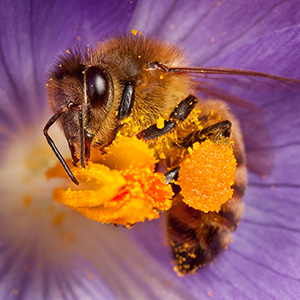
Are regulations keeping bees safe?
There is so much more to be said of pesticide regulation when it comes to bees. One glaring problem is that testing has so often been done only on honey bees (which are such outliers in the bee world of some 21,000 other bee species). Testing also almost always focuses only on adult bees.
Perhaps worst of all, most studies consider only death, rather than impairment of learning, memory, immunity, growth, or other sublethal effects in bees.
Further gaps in testing
"Inert" ingredients often make up the bulk of formulations, but these go entirely untested (and yet may be as dangerous as the regulated chemical, or may enhance and compound the main chemical's threats). Studies also focus solely on the main chemical ingredient, rather than the cocktail of chemicals that bees encounter in the field (which interact and amplify each other in unknown ways).
Further, micro-encapsulation and seed dressings make it so that the parts of the plants that bees interact with—namely, pollen and nectar—become poisons too, eaten not just by adult bees, but becoming provisions for raising young bees (of all kinds, social and solitary).
These compounds also produce resulting metabolites as chemicals break down in the field, and these metabolites can be even more toxic, as well as persisting in, and building up within, the environment.
The chemical industry helped write (and rewrite) the Toxic Substances Control Act:
But industry magnates were so intimately involved in the drafting of the original 1976 bill that the EPA’s first assistant administrator for its chemical division joked the law was “written by industry” and should have been named after the DuPont executive who went over the text line by line.
Bees wish to eat organic too!
If you're a bee, simply going for brunch—let alone collecting food for your offspring—is now a dangerous proposition. What looks and smells like a tasty flower may hide all manner of subtle dangers.
Chemicals are currently considered innocent until proven otherwise—something which flies in the face of common-sense precautions around such intentionally toxic substances. New pesticides are continuously developed and brought to market, without meaningfully independent, peer-reviewed studies investigating the possibilities of unintended consequences.
“Man is a part of nature, and his war against nature is inevitably a war against himself.”
—Rachel Carson, in her book Silent Spring
The apparent, short-term benefits of our chemical warfare on nature continue to result in serious, ongoing, and at times catastrophic environmental consequences.
Like us, bees love healthy, untainted food... if only they could find it!
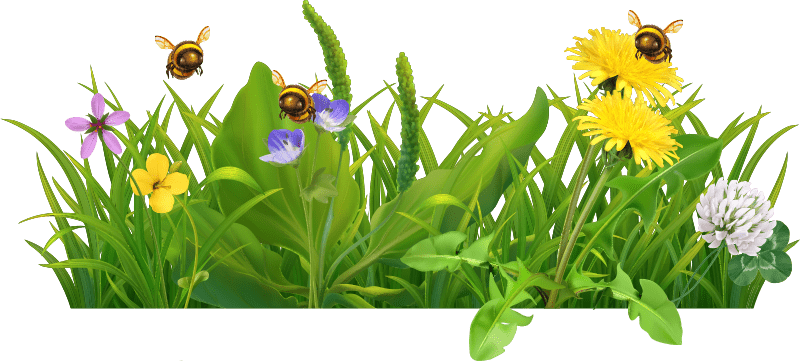
What can I do to help?
Offer local bees a diverse banquet during all temperate seasons of the year (generally bees are active from early spring through late autumn).
- Plants to choose for your area
- Tips on sourcing bee-friendly plants
- Creating native wildflower meadows
Offer spots for bees to live, plus any raw building materials. Create a perfect habitat for bees in your garden, balcony, workplace, or community.
- Operating your own "bee hotel"
- Creating your own "bee bank"
- Observation boxes for solitary bees

